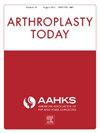Exploring Acute Kidney Injury Incidence in Hip Periprosthetic Joint Infection Treatment With Combined Intravenous and Intra-articular Antibiotic Infusion
IF 1.5
Q3 ORTHOPEDICS
引用次数: 0
Abstract
Background
Periprosthetic joint infections (PJIs) are a significant complication following total hip arthroplasty, impacting patient health and healthcare costs. This study examines the incidence of acute kidney injury (AKI) in patients undergoing hip PJI treatment with a combination of intravenous and intra-articular antibiotic infusion therapies.
Methods
A retrospective review of 151 patient records from May 1, 2010 to December 30, 2022 was conducted at a single academic hospital. Patients were treated for hip PJIs using debridement, antibiotics, and implant retention or single-stage revision surgeries. AKI was classified according to the Kidney Disease: Improving Global Outcomes criteria.
Results
Among 151 patients, 17 (11.26%) developed AKI, with 13 cases resolving transiently before discharge. The median onset of AKI was on postoperative day 2, with stage I AKI being the most prevalent, accounting for 64.71% of cases. Diabetes and low baseline serum creatinine levels were identified as independent risk factors for AKI, with odds ratios of 9.69 and 1.09, respectively.
Conclusions
The combined regimen of intra-articular and intravenous antibiotic infusion appears to have a manageable risk profile regarding AKI. This approach could serve as a viable alternative for PJI management, emphasizing the importance of careful patient monitoring and tailored antibiotic regimens. Further studies are recommended to optimize treatment protocols and mitigate risks.
求助全文
约1分钟内获得全文
求助全文
来源期刊

Arthroplasty Today
Medicine-Surgery
CiteScore
2.90
自引率
0.00%
发文量
258
审稿时长
40 weeks
期刊介绍:
Arthroplasty Today is a companion journal to the Journal of Arthroplasty. The journal Arthroplasty Today brings together the clinical and scientific foundations for joint replacement of the hip and knee in an open-access, online format. Arthroplasty Today solicits manuscripts of the highest quality from all areas of scientific endeavor that relate to joint replacement or the treatment of its complications, including those dealing with patient outcomes, economic and policy issues, prosthetic design, biomechanics, biomaterials, and biologic response to arthroplasty. The journal focuses on case reports. It is the purpose of Arthroplasty Today to present material to practicing orthopaedic surgeons that will keep them abreast of developments in the field, prove useful in the care of patients, and aid in understanding the scientific foundation of this subspecialty area of joint replacement. The international members of the Editorial Board provide a worldwide perspective for the journal''s area of interest. Their participation ensures that each issue of Arthroplasty Today provides the reader with timely, peer-reviewed articles of the highest quality.
 求助内容:
求助内容: 应助结果提醒方式:
应助结果提醒方式:


